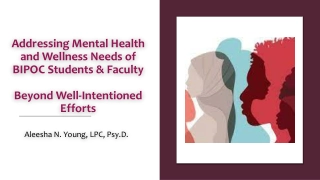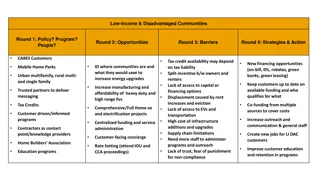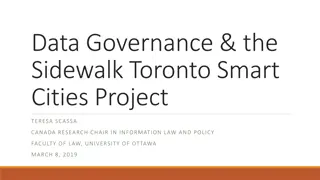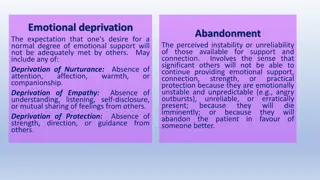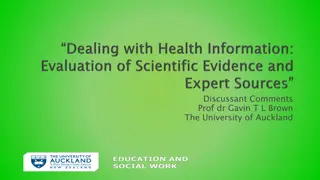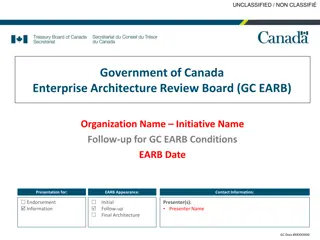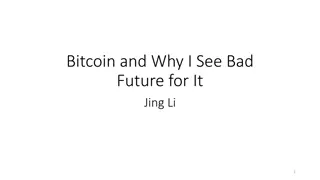
Understanding Medical Mistrust and Its Implications
Explore the definition, sources, consequences, and global evidence of medical mistrust in healthcare systems. Discover ways to prevent and address mistrust, recognizing its negative impact on patient-provider relationships and healthcare outcomes. Learn about the threats posed by mistrust, including disparities in health seeking behavior and medication adherence. Uncover the socio-economic factors, race, ethnicity, gender disparities, and historical events contributing to medical mistrust.
Download Presentation

Please find below an Image/Link to download the presentation.
The content on the website is provided AS IS for your information and personal use only. It may not be sold, licensed, or shared on other websites without obtaining consent from the author. If you encounter any issues during the download, it is possible that the publisher has removed the file from their server.
You are allowed to download the files provided on this website for personal or commercial use, subject to the condition that they are used lawfully. All files are the property of their respective owners.
The content on the website is provided AS IS for your information and personal use only. It may not be sold, licensed, or shared on other websites without obtaining consent from the author.
E N D
Presentation Transcript
By Ariam H. (MPH) 8/21/2025
Definition Source of mistrust Consequence of mistrust Global evidence How to prevent mistrust Measurement of mistrust Addressing mistrust 8/21/2025
Medical Mistrust in the health system can be defined as a lack of confidence or trust in the healthcare institution, systems, policies, and caregivers . Shall I trust you? Trust me! I am a doctor 8/21/2025
Mistrust in the health system can arise in several ways 1. Lack of transparency 2. Poor communication 3. Discrimination 4. Medical errors 8/21/2025
Mistrust in the health system can be a threat to public health because it can lead to Delayed treatment Decreased adherence to treatment Vaccine hesitancy Unwillingness to participate in clinical research and trials 8/21/2025
Negative impact of medical mistrust on patient provider relationships Medical mistrust has an implication on healthcare outcomes and disparities Medical mistrust can affect healthcare access and utilization and clinical decision making 8/21/2025
Mistrust can lead to a Varity of negative outcomes including Limited health seeking behavior Medication non adherence Disparities in health outcomes 8/21/2025
socio economic factors, race, ethnicity, and gender disparities that contributes to medical mistrust Implicit biases and cultural differences leads to mistrust 8/21/2025
There are historical events that contributed to medical mistrust , such as unethical medical experiments or systematic biases 8/21/2025
There are numerous global evidences and scientific papers that are published on the area 1. The Tuskegee syphilis study 1972). Involved leaving untreated syphilis in African American men without their informed consent. 2. Flint water crisis contamination of city s water with lead which resulted in widespread public health issues. 1. The Tuskegee syphilis study conducted in alabama(1932 - 2. Flint water crisis in 2014 in Michigan , involved 8/21/2025
3. COVID 19 pandemic numerous misinformation, political interference, and racial disparities in health care. COVID 19 pandemic there has been 8/21/2025
Providers should: Providers should: 1. Discuss mistrust openly 2. Clear communication 3. Build a partnership with patients. 4. Address systemic issues 8/21/2025
Patients should: Patients should: 1. Be respectful 2. Ask questions if unsure of anything/Health literacy 3. Be your own advocate when discussing your health 4. Understand there are multiple patients being taken care of and no one patient s needs are more or less important than another 8/21/2025
Preventing medical mistrust is critical as it can have detrimental effects on patient outcomes and healthcare delivery. 1. Build trust through communication 2. Addressing cultural competence 3. Establish equitable care 8/21/2025
4. foster patient engagement 5. Addressing systematic issue 8/21/2025
Can be challenging as it is complex construct with various dimensions that can be difficult to quantify. Medical mistrust is seen as a barrier to health promotion and addressing health disparities Number of measuring tools 8/21/2025
1. Self report measure used method. Patients are requested to scale their level of mistrust using Likert scales or other rating systems. E.g. trust in medical professionals scale( TMP) and the Mistrust in medical research scale(MMRS), Health system distrust scale, group based medical mistrust scale, institutional mistrust scale 1. Self report measure - the most commonly 8/21/2025
2. Behavioral observations health care settings to identify signs of mistrust like patients who avoid eye contact or appears tense. 2. Behavioral observations - Observing patients behavior in 8/21/2025
3. Physiological measures signs which are objective assessment of patients emotional response 3. Physiological measures like measuring HR and other clinical 4.Implicit measures attitudes and beliefs about health care providers and systems. E.g Implicit associations test(IAT) 4.Implicit measures- - involves assessing patients unconscious 8/21/2025
A Major finding : associated with poorer healthcare access, less healthcare utilization and worse health outcomes. 1 variability in measurement 2 contextual consideration 3 impact on patient outcome 4 suggest strategies A systematic review of medical mistrust measures Major finding : the review found that medical mistrust was systematic review of medical mistrust measures 8/21/2025
The study sought to more fully understand the conceptualization and measurement of medical mistrust. Medical mistrust is a widely-cited barrier, but there has been little systematic attention to what scholars are measuring when they measure medical mistrust 8/21/2025
To create interventions that overcome this barrier, we must first understand and be attuned to the ways in which medical mistrust is conceptualized. The framing of medical mistrust not only shapes our understanding of individuals perceptions, but also influences how we tackle the barrier (e.g., attention is on attitudes of individuals versus tackling institutional policies). 8/21/2025
Not objectively studied but there are indicators in general such as 1. CRC 2. Health service quality 3. Health providers behavior 4. increase in the cost of healthcare We are trying to commence small scale research on medical mistrust in Ethiopia . So I hope it will contribute to the knowledge body of medical mistrust 8/21/2025
Providing strategies to build trust between health care providers and patients Important to create culturally competent care and patient centered communication Highlighting policies and initiatives at reducing medical mistrust 8/21/2025
Encouraging open dialogue and discussion about medical mistrust in health care setting Proposing educational initiatives to increase awareness of medical mistrust among healthcare professionals and the general public 8/21/2025
Towards a More Inclusive and Dynamic Understanding of Medical Mistrust Informed: by Science Jessica Jaiswal & Perry N. Halkitis A systematic review of medical mistrust: measures Lillie D. Williamson*, Cabral A. Bigman Department of Communication, University of Illinois at Urbana-Champaign, Urbana, IL, USA Distrust of the Health Care System and Self-Reported Health in the United States: Katrina Armstrong, Abigail Rose,1 Nikki Peters, Judith A. Long, Suzanne Mc Murphy, Judy A. Shea, 8/21/2025
Thank being here Thank you for being here you for 8/21/2025

